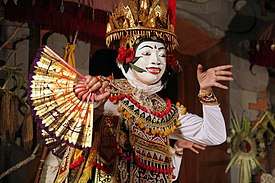Gambuh
Gambuh is an ancient form of Balinese dance-drama. It is accompanied by musicians in a gamelan gambuh ensemble.
_%E2%80%94_11_arya.jpg) Gambuh performance depicting an arya or nobleman | |
| Origin | Indonesia |
|---|---|
| Gambuh |
|---|
|
| Burma |
| Cambodia |
|
| Indonesia |
|
| Laos |
| Malaysia |
| Philippines |
| Thailand |
| Vietnam |
| Music of Indonesia | |
|---|---|
 Kempul gongs from Java | |
| Genres | |
| |
| Specific forms | |
| Regional music | |
History
Gambuh is one of the oldest surviving forms in Balinese performing arts,[1][2][3] dating to the late Majapahit era (ca. 15th century) with very little known change since this time.[2][4] Emiko Susilo writes, "when the dance-dramas of Majapahit came to Bali, they had the new task of preserving the tradition of a fallen dynasty"[4] (emphasis in original). It also introduced a new element of narrative to Balinese performing arts that influenced other forms of dance-drama on the island, such as topeng masked dance and arja opera.[4] For centuries it was supported by patronage at the royal courts of Bali's aristocracy, during which it achieved its greatest heights of sophistication. As the courts fell apart in the bloody wars with the Dutch, this support evaporated and much of the art of gambuh was lost. Like the many other arts that formerly depended on royal patronage, gambuh found some community support by playing for temple ceremonies.[1]
Gambuh is now nearly extinct. In 1997, Susilo observed, "In total there are perhaps only four groups that perform in the Gambuh style."[4] It is unpopular even among Balinese performers. The dance and music are technically exacting and complex; the dialogue requires knowledge of the Kawi language. Performances are long and, unlike wayang shows, contain no comic relief, making demands of potential audiences.[4]
Dramatic components
Combining dance, music, and acting, gambuh draws on the narrative material of the Malat, a series of poems about the fictional Javanese Prince Raden Panji, an incarnation of Wisnu. On his wedding night, he is separated from his fiancée, Candra Kirana, beginning an epic in which the two lovers search for each other over years and across wide areas of medieval Java. They finally meet on the field of battle, recognize each other through their disguises, and live happily ever after.[4] Other characters include members of the court and their servants. The refined (alus) characters speak in Kawi, an old literary tongue, which is translated for the audience into contemporary Balinese by the characters of lower status.[1]
Gamelan gambuh
A complete gamelan gambuh requires approximately 17 musicians to accompany the dance-drama. The main instruments in gambuh performances are very low bamboo flutes called suling gambuh, between 75 and 100 cm in length and 4 and 5 cm in diameter. There are usually four such flutes, but sometimes as few as two or as many as six.[5] The suling gambuh play melodies along with a rebab while percussion instruments fill out the sound with a variety of timbres and rhythms: a medium-sized gong, a small gong called kajar, two kendang, a chime called klenang, a bell tree called gentorag, rincik (reminiscent of a ceng-ceng), a metallophone called kenyir, kangsi, and gumanak.[1][3] The last three of those instruments—the kenyir, kangsi, and gumanak—are not currently found in any other gamelan ensemble of Bali.[5]
Gallery
See also
References
- Dennis Kennedy, ed. (2003). "Gambuh". Oxford Encyclopedia of Theatre and Performance. 1. Oxford University Press. p. 495.
- I Made Bandem and Fredrik deBoer (1978). "Gambuh: A Classical Balinese Dance-Drama in Asian Music". 10. University of Texas Press: 115–127. JSTOR 834127. Cite journal requires
|journal=(help) - Tenzer, Michael (1991). Balinese Gamelan. Periplus Editions. ISBN 0-945971-30-3. Page 20.
- Emiko Susilo (1997). "Gambuh: A Dance-Drama of the Balinese Courts in Explorations in Southeast Asian Studies: A Journal of the Southeast Asian Studies Student Association, Vol 1, No. 2, Fall 1997". University of Hawai'i Southeast Asian Studies Student Association. Archived from the original on 2010-06-04. Retrieved 2011-04-27.
- I Nyoman Rembang, I Wayan Sudiana, Tilman Seebass, Wayne Vitale (editor). Music Gambuh Batuan dan Pedungan.CS1 maint: uses authors parameter (link)
.svg.png)
_%E2%80%94_02_Condong_%26_Kawan-2.jpg)
_%E2%80%94_11_gambelan.jpg)
_%E2%80%94_24_JEFF_tukang_suling.jpg)

